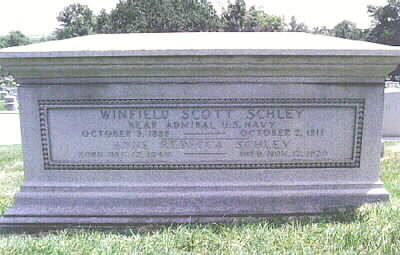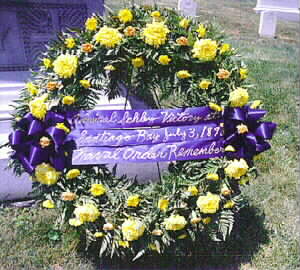Born at Frederick City, Maryland, October 9, 1839. Appointed t to the United states Naval Academy from Maryland, 1856, and graduated in 1860. Married: Annie R. Franklin, September 10, 1863.
Promoted to midshipman, Jun 15, 1860, Master, July 25, 1866, Commander, June 19, 1874, Captain, March 31, 1888, Commodore, February 6, 1898, Rear Admiral, March 3, 1899.
Served on USS Niagara, 1860-61, USS Keystone State, 1861, USS Potomac storeship, at Ship Island, 1861-62, USS Winona, West Gulf Blockading Squadron, 1862-63. Participated in engagement with a battery near Port Hudson, December 14, 1862, engagements which led to capture of Port Hudson, March-July 1863. Served on USS Wateree, Pacific Squadron, 1864-66.
Duty at the Naval Academy, 1866-69, 1872-76. Served on USS Benicia, 1869-72. Participated in attack on Salee River forts, Korea, 1871. Commanded, USS Essex, 876-79. Light house inspector, 2nd dist, 1880-83. Commanded USS Thetis and Greely Expedition, 1884, rescued Lieutenant Greely and 6 survivors at Cape Sabine, for which was awarded gold watch and vote of thanks of the Maryland legislature and a gold medal from Masssachusetts Humane Society. Chief, Bureau of Equipment and Repair, 1884-89. Commanded USS Baltimore, 1889-92. Member Board of Inspection and Survey, 1896-97. Chairman, Lighthouse Board, 1897-98.
During the Spanish-American War, he commanded Flying Squadron, 1898. In immediate command in the battle of Santiago de Cuba, July 3, 1898, which resulted in the destruction of Admiral Cevera’s Spanish fleet. Commander-in-Chief, South Atlantic Squadron, 1899-1901. Retired October 9, 1901. Presented with a gold sword by the people of Pennsylvania, a silver sword by Royal Arcanum, a gold and jeweled medal with thanks of Maryland legislature, silver service, for services at the battle of Santiago. Author: “The Rescue of Greely,” 1885, & “Forty-5 Years Under The Flag,” 1904.
After a routine cruise in Pacific on the Niagara ordered in 1861 to Potomac in West Gulf Blockading Squadron. Later, on gunboat Winona and sloops Monongahela and Richmond, distinguished himself in operations before Mobile and took part in the campaign leading to capture of Port Hudson. July 1862 promoted to Lieutenant In 1864-66 again in the Pacific on USS Wateree.
Promoted to Lieutenant Commander, July 1866, he taught at the Naval Afcademy, 1866-69; served on Benicia on Asiatic Squadron in 1869-73, taking part in landing and capture of Korean forts at Han River in June 1871 under Commander John Rodgers; again at the Naval Academy, 1873-75, advanced to Commander June 1874. Commanded Essex in the Brazil Squadron in 1876-79 and then was a lighthouse inspector in Boston, 1879-83.
In 1884 was given command of an expedition to rescue Arctic party under Army Lieutenant Adolphus Washington Greely, who had been out of touch in Greenland since 1881. With vessels Thetis, flagship Bear, and Alert, pushed northward through precariously icy seas to Cape Sabine and there on June 22 discovered Greely and 6 other survivors of the party.
From 1884 to 1889 was chief of Bureau of Equipment and Recruiting, receiving promotion to Captain in March 1888. In 1889 took command of the cruiser Baltimore in South Pacific. October 16, 1891, a liberty party off the Baltimore was attacked by a mob in Valparaiso, Chile, and two sailors were killed. He maintained a firm but tactful presence in harbor until relieved by USS Yorktown, commanded by Robley D. Evans, in November.
He was a Lighthouse Inspector again in 1892-95, commanded the New York in 1895-97, and then was Chairman of Lighthouse Board in 1897-98. Promoted to Commodore in February 1898, and given command of the “Flying Squadron” based at Hampton Roads, Virginia, at the outbreak of the Spanish-American War in April.
The squadron’s mission was to be ready to meet any Spanish force in Atlantic or Caribbean. In May, the Spanish fleet under Admiral Cervera, having been detected making for Cuba, he was ordered to join his squadron to the main fleet under Admiral William Thomas Sampson, to whom he was technically superior in rank. Sampson ordered him on May 18 to blockade southern Cuban ports, principally Santiago and Cienfuegos, but before he organized his forces Cervera slipped into Santiago on May 19. He took up a position outside Santiago on May 26, but a few hours later left, intending to return to the main Navy base at Key West, Florida, to refuel. He managed a refueling at sea, however, and resumed his position outside of Santiago on May 28, being joined by Sampson on June 1.
On the morning of July 3, while Sampson was on his way to conference ashore, Cervera’s fleet attempted to run blockade. Though in immediate command, he issued no special orders, and the squadron executed Sampson’s standing orders to run down Spanish fleet. The principal exception was the cruiser Brooklyn, Schley’s flagship, which unaccountably turned in direction opposite that of the rest of squadron, causing considerable confusion and narrowly escaping collision with the Texas. The Brooklyn was nonetheless conspicuous in battle, particularly against Cervera’s flagship Maria Teresa, which was run ashore. Schley, the senior office present, was eager to accept credit for victory, while newspapers and the public, to whom he was already a familiar and heroic figure, were eager to give it, ignoring the somewhat aloof Sampson. A controversy quickly developed, delaying promotions of both men until March 1899, when both were made Rear Admiral.
He served on the Puerto Rico Evacuation Commission September-October 1898, and after brief period as president of a Retirement Board, given command of the South Atlantic Squadron in 1899, a post he retained until he retired in October 1901. By that time the Sampson-Schley controversy had become even more heated, at least on the parts of their respective partisans, and in July 1901 he requested and was granted court of inquiry. In December a majority of the court, presided over by George Dewey, reported against Schley, particularly in matters of tardy movements, the outward turn of the Brooklyn, and other matters. Dewey himself, however, submitted a minority report in his favor. On appeal, Theodore Roosevelt approved majority report in January 1902. His autobiography “Forty-5 Years Under The Flag,” appeared in 1904.
He died on, October 2, 1909, 7 days before his 70th birthday, in New York City. A gate at Arlington National Cemetery was named in his honor, and he was buried in Arlington on October 5, 1909, after a Masonic service at his home on I St, Washington, DC, and services at St John’s Church.
His wife, Annie Rebecca Franklin Schley, who was born on December 12, 1840, died on November 17, 1920 while living with their son, Dr. Winfield Scott Schley, at 565 Park Avenue in New York City. She had fallen and was taken to St Lukes’s Hosp where she developed pneumonia.She lies buried with her husband in Section 2 of Arlington National Cemetery.
SCHLEY, ANNIE R W/O WINFIELD S
- DATE OF DEATH: 11/17/1920
- DATE OF INTERMENT: 11/28/1920
- BURIED AT: SITE 1207
- ARLINGTON NATIONAL CEMETERY
- WIFE OF WS SCHLEY – RADM USN
Michael Robert Patterson was born in Arlington and is the son of a former officer of the US Army. So it was no wonder that sooner or later his interests drew him to American history and especially to American military history. Many of his articles can be found on renowned portals like the New York Times, Washingtonpost or Wikipedia.
Reviewed by: Michael Howard


